Building a Collection #83
Symphony No. 2 in E minor, Op. 27
By Sergei Rachmaninoff
____________
I compose music because I must give expression to my feelings, just as I talk because I must give utterance to my thoughts.
-Sergei Rachmaninoff
Welcome back! We arrive at #83 on our way to the top 250 classical works of all-time, and once again we encounter the beloved Russian composer Sergei Rachmaninoff. At this entry is Rachmaninoff’s wonderful Symphony No. 2, a work that has only gained in popularity as the decades have passed.
Sergei Rachmaninoff
Sergei Rachmaninoff (also often spelled Rachmaninov) was born in Semyonovo, Russia in 1873 and died in Beverly Hills, California in 1943. Rachmaninoff was one of those rare artists who excelled as a performer, conductor, and composer. During his lifetime, he was known as one of the greatest pianists of all time and also the last great composer of the Russian Romantic tradition. Sergei was raised in a music-loving, aristocratic family and his mother fostered the natural ability he showed by giving him piano lessons. It was clear early on that Sergei possessed prodigious talent, and when the family fortunes declined, they moved to St. Petersburg, where the boy entered the conservatory. Eventually as he continued to impress, he was sent to the Moscow Conservatory. There he received lessons from the strict Nikolay Zverev and his own cousin Alexander Siloti. As he grew in maturity and musical prowess, Rachmaninoff also made the acquaintance of many important and influential contacts in the music world.
Rachmaninoff became good friends with Tchaikovsky along the way, and the elder Tchaikovsky became quite an advocate for the young pianist. While at the conservatory, Rachmaninoff also displayed significant compositional gifts, eventually winning the gold medal in composition for his opera Aleko in 1892. Rachmaninoff was prone to depression, and when his Symphony no. 1 was received poorly in 1897, he went into an extended depression and withdrew from composing for several years. Later it was revealed that the orchestra for the premiere had been very poorly rehearsed, and the conductor Alexander Glazunov had likely been intoxicated while on the podium. Rimsky-Korsakov remarked after hearing a rehearsal, “Forgive me, but I do not find this music at all agreeable.”
The assessment from Russian composer and critic Cesar Cui was the most cutting:
“If there were a conservatory in Hell, and if one of its talented students were to compose a programme symphony based on the story of the Ten Plagues of Egypt, and if he were to compose a symphony like Mr. Rachmaninoff's, then he would have fulfilled his task brilliantly and would delight the inhabitants of Hell. To us this music leaves an evil impression with its broken rhythms, obscurity and vagueness of form, meaningless repetition of the same short tricks, the nasal sound of the orchestra, the strained crash of the brass, and above all its sickly perverse harmonization and quasi-melodic outlines, the complete absence of simplicity and naturalness, the complete absence of themes.”
A later reassessment of the symphony would redeem it from its dismal initial reception, but the blow would haunt Rachmaninoff for the rest of his life.
In his depression, Rachmaninoff turned to hypnosis, which provided some relief. After a four-year period of self-doubt, Rachmaninoff returned with a huge success in his Piano Concerto no. 2 in 1900-01. The concerto almost assured him of lasting renown, with its large romantic melodies and virtuosic piano runs and climaxes. In popular culture, Frank Sinatra used themes from the first and third movements respectively for his songs I Think of You and Full Moon and Empty Arms. Perhaps more familiar is Eric Carmen’s 1975 ballad All by Myself based on the second movement.
His career resurrected, and after marrying his first-cousin Natalya Satina in 1902, Rachmaninoff would go on in the first decade of the new century to compose some of his most well-known and enduring works: Isle of the Dead (1907), Symphony no. 2 (1907), and his Piano Concerto no. 3 (1909).
Keep in mind that Rachmaninoff was not really making a living from composing, but rather from performing as a pianist and conductor. In 1904, Rachmaninoff agreed to become the conductor of the famed Bolshoi Theatre for two seasons. As a conductor, Rachmaninoff received mixed reviews as musically discerning but also very demanding and exacting of his players. During his second year in the post, he tired of the job and handed in his resignation in February of 1906. Unhappy with the political climate in Russia at the time, he packed up his family and moved them to Dresden, Germany, where they stayed until 1909. During this time, Rachmaninoff completed work on his Symphony no. 2 and it premiered in 1908. It was to become his greatest orchestral success.
During his time in Dresden, Rachmaninoff also agreed to travel to the United States for the first time to perform as a soloist and conductor in a series of concerts in 1909-10 with the Boston Symphony Orchestra and conductor Max Fiedler. While preparing for the trip, he worked on a new concerto which would become his Piano Concerto no. 3, which he hoped to premiere on the trip. In Boston he performed 26 times, 19 as a soloist and 7 as a conductor. Interestingly, his first appearance for recital was at Smith College in Northampton, Massachusetts on November 4th, 1909. Shortly after he gave the second ever performance of his Piano Concerto no. 3 as the soloist accompanied by the New York Symphony Orchestra conducted by legendary conductor and composer Gustav Mahler. This would be one of Rachmaninoff’s most memorable moments in the United States.
Upon his return to Russia in 1910, Rachmaninoff was appointed the head of the Imperial Russian Musical Society but eventually resigned when he discovered that an administrator was dismissed for being Jewish. In the following years, he would compose The Bells and his All-Night Vigil as World War I heated up. Rachmaninoff went on tours in England and Europe performing his own works and for the first time including works by other composers. In February 1917, at the beginning of the Russian revolution, Rachmaninoff returned to his estate in Ivanovka only to find it had been confiscated by the Social Revolutionary Party. Rachmaninoff left within weeks and vowed never to return. After a vacation in Crimea with his family, they moved to Moscow and lived in a collective for a time amid chaos and violence outside their doors.
Soon after, Rachmaninoff received offers from Scandinavia to perform recitals, which he quickly accepted mostly for the purpose of obtaining permits for his family to leave Russia. Packing lightly, and traveling through Finland by train and sled, they eventually arrived in Stockholm and then settled in Copenhagen. During this time, Rachmaninoff mostly performed live in recitals throughout Scandinavia as a means of income. As a result, he had to learn many new pieces by other composers, which greatly increased his repertoire. Despite receiving offers from the United States to conduct the Cincinnati Symphony Orchestra, the Boston Symphony Orchestra, and to tour giving recitals, Rachmaninoff declined them all. But he changed his mind after realizing that the United States could be financially advantageous for his family. He found a way to raise enough money for his entire family to travel from Oslo, Norway to New York City on the SS Bergensfjord.
Rachmaninoff toured extensively in the USA and began an exclusive relationship with the Steinway piano company. Soon finances were no longer an issue, and the family lived quite well in New York City with many of the luxuries of the day. Rachmaninoff also began a recording relationship with RCA Victor in 1920, which would carry on through the rest of his career. He would also become well off enough to periodically send money to friends and family in Russia that were suffering through the Revolution. In the early 1920s, Rachmaninoff toured widely in England and Europe, solidifying his fame. In 1924, he once again declined to be the conductor of the Boston Symphony Orchestra. Leaving his home country had blunted his desire to compose, and he didn’t compose again until 1930 when he was spending summers in France. He would compose his well-known Rhapsody on a Theme of Paganini there in 1934.
Rachmaninoff would sign on to an article in the New York Times denouncing the cultural policies in the Soviet Union, and as a result he was boycotted from entering the country.
In his remaining years, Rachmaninoff would continue to perform and compose, albeit at a much slower pace. Various health issues arose, and eventually he was advised by his doctor to move to a warmer climate. In 1942 he moved with his family to Beverly Hills, California. By this time, Rachmaninoff had befriended Vladimir Horowitz and Igor Stravinsky, both of whom had also fled their homelands to the USA. The 1942-43 season would be his last season of performing, and even though he was still brilliant, he was very fatigued. He passed away in March 1943, a few days short of his 70th birthday. In his will, Rachmaninoff had requested to be buried in Russia, but since he had become a US citizen that was impossible at the time. In August 2015, Russia requested that Rachmaninoff’s remains be moved back to his homeland because they contended America had neglected his burial place but had profited commercially from his name. His descendants have resisted this request, claiming that Rachmaninoff had chosen to make the USA his homeland after political exile from the Soviet Union. His remains are buried in Valhalla, New York.
As a pianist, Rachmaninoff was known for his precision, clarity, and consistent legato line (legato means smooth or flowing). Rachmaninoff’s hands themselves became something of a legend as well, since he had enormous hands and a very wide span with his fingers. He was able to play even the most difficult chords with ease, and he had an unbelievable ability to make full use of the keyboard. There is speculation Rachmaninoff suffered from acromegaly, which could explain his large hands and feet, as well as his depression.
The music Rachmaninoff composed is noted for its highly romantic style, beautiful and memorable melodies, and rich harmonies. There is no doubt his career as a pianist greatly influenced his compositions, especially as he created so many works for solo piano. His early works were influenced by Tchaikovsky, whom he revered, but soon he would find his own voice and style that became very recognizable. Rachmaninoff’s use of changing rhythms, sweeping lyricism, and compact use of themes became hallmarks of his style. His melodies are passionate and unabashedly sentimental, and as he grew as a composer, he became more adept at contrasting orchestral color and textures. He was also a master of counterpoint and fugue and used it well. Much of his structure was related to his love of Russian choral music, and this can be heard in almost all his works, especially his use of chords spaced apart for effect.
While certainly tonal in nature, Rachmaninoff’s music also contains an original style and genuinely sounds modern due to his use of chromaticism between tones and his careful use of dissonant harmonies. While some early critics said his works were shallow, gushing, and artificial, most now agree that Rachmaninoff’s greatest works are likely to endure forever.
Symphony no. 2
Rachmaninoff’s Symphony no. 2 in E minor was composed between 1906 and 1907 and is in the traditional four movements. The premiere was given in Saint Petersburg on January 26, 1908, with Rachmaninoff conducting. It is dedicated to Russian composer Sergei Taneyev. The full length of the symphony without cuts is about an hour in playing time, but it was common for many years for conductors to make cuts which reduced the length. This happened particularly in the 1940s and 1950s, but nowadays it is standard for orchestras to play the full symphony, although occasionally you will hear the repeat of the exposition cut out of the first movement. Naturally, Rachmaninoff was vehemently opposed to any cuts to his symphony, telling Eugene Ormandy, “You don’t know what cuts do to me. It is like cutting a piece out of my heart.”
After the cold reception of his Symphony no. 1, Rachmaninoff had doubts about his ability as a symphonic composer. This perhaps led to the many revisions he made in the score of his Symphony no. 2, as his confidence was lacking. But the premiere was a great success, with the applause going on for a long time after the conclusion. This was the success that cemented Rachmaninoff’s legacy as a composer.
The symphony’s movements are as follows:
Largo – Allegro moderato (E minor)
Allegro molto (A minor)
Adagio (A major)
Allegro vivace (E major)
Steven Ledbetter, program annotator for the Boston Symphony Orchestra, comments on the symphony:
“The Second Symphony’s very first phrase in the cellos and basses is the essential motto, which dominates the symphony on its surface or somewhere in the undertow. Its melodic turn is at once converted into an expressive figure in the violins in the first of many elaborations. A new one occurs in the restless Allegro that follows. The A minor scherzo movement is one of Rachmaninoff’s most original in character and scoring, right from the opening horn theme, which is a rather festive march, and the violin figure that follows will return to open the symphony’s finale. Periodically the movement softens into a lyrical stepwise melody before returning to the energetic business for which the movement is intended to serve. At the end, a coda dies away into nothingness.
A high point of the symphony comes in the third movement, one of the most romantic passages in the entire orchestral repertory. The passion hinted at in the introductory measures return in full force at the climax. But first the clarinet sings a long, tender song expanding without repetition for twenty-three measures. The middle section is lightly scored, with brief questions and answers tossed back and forth by the English horn and oboe against reminders in the violins of the symphony’s opening motto. A long crescendo leads to the climactic statement of the romantic opening figure of the movement. This quickly collapses, though, and the motto intertwines with the romantic figure in mysterious dialogue, leading to the restatement of the clarinet song. Another romantic climax ensues, and the movement dies away in a dialogue of murmuring calm.
The finale abruptly breaks the romantic atmosphere with a theme full of triplets rushing headlong in a carnival mood. Recollections of earlier movements are woven into this madcap chase with great subtlety, and the string choir has the opportunity to introduce (in unison) another of Rachmaninoff’s great soaring, singing melodic inventions. A brief Adagio recalls the slow movement and the violin version of the opening motto before we plunge into the development section, which contains one of Rachmaninoff’s greatest masterstrokes. Gradually one instrument and then another begins to play a descending scale, first in quarter-notes, then some in eighth-notes or whole notes, overlapping and making an extraordinary noise, as if someone were ringing the changes on all the bells of Moscow at once. A recapitulation and swift coda ends the symphony in a truly resplendent manner.”
You may recognize parts of the third movement from Eric Carmen’s 1976 song Never Gonna Fall in Love Again. Because Rachmaninoff’s music was copyrighted at the time, Carmen was forced to pay royalties to the Rachmaninoff estate both for his use of this melody and for borrowing a tune from Piano Concerto no. 2 for All by Myself. Other jazz and popular artists have used other portions of Rachmaninoff’s melodies including Barry Manilow, Chet Baker, and Isao Tomita.
There is something universally appealing about Rachmaninoff’s music, and he could not help but wear his heart on his sleeve in his compositions. If you are not familiar with this life-affirming work, I urge you to hear it in all haste.
The Essential Recording
German American conductor, composer and pianist André Previn had his greatest success as a conductor during his time as Principal Conductor of the London Symphony Orchestra between 1968 and 1979. It was in 1973 that he released what is arguably the most acclaimed recording of his career, Rachmaninoff’s Symphony no. 2 with the LSO. There are other great recordings of this symphony, but none which capture the essentially lyrical and emotional nature of the work so completely. The recording is a complete triumph in every way.
If you need proof, just listen to the Adagio from about 5’00’ until just after 8’00”. The way Previn builds the crescendo here is utterly amazing to me, and if this doesn’t pull at your heart, I don’t know what to say. The LSO and Previn had played this symphony many times on tour prior to the recording, and had even played it in Moscow, where the audience was reportedly weeping during the performance. On the recording what strikes me most are the cascading, undulating, and soaring strings of the LSO captured in a warm and resonant acoustic that mimics a concert hall experience. The Kingsway Hall acoustic is clearly an asset but just know this is a “soft-grained” recording which rounds out the edges rather than giving us great detail. For this symphony, it works extraordinarily well.
Previn allows the music to breathe in a way that feels most natural, and he never pushes too hard, nor does he sit back too much. The orchestra and Previn have what sounds like a unity of approach which leads to if not perfection, then something quite close.
Recommended Recordings
Even with its dated sound, the 1947 recording from Dimitri Mitropoulos and the Minneapolis Symphony Orchestra on Sony makes my recommended list. I like Mitropoulos’ extroverted approach which I believe plumbs the depths of this emotional score more than most, and which tends to bring out more instrumental color. The opening movement has a darkness and an intensity that I feel serves the music well. I listened to this recording immediately after hearing another recording which was well played but had no soul, and Mitropoulos is the exact opposite. He brings personality, soul, and drama. For some listeners this may be too far to the expressive end of things, for me it is ideal for this symphony.
The 1956 recording by German-Jewish conductor Kurt Sanderling and the Leningrad Philharmonic Orchestra on Deutsche Grammophon has long been held up as a reference recording for this symphony. Recorded in the excellent acoustic of the Jesus-Christus-Kirche in Berlin, it remains near the top despite sound which is below par even for 1956. Sanderling was removed from his post in Germany in 1936 for being Jewish, and he moved to Moscow. After working in the Soviet Union for some time, he returned to East Germany where he conducted for many years. On this recording we hear Sanderling lead a typically “Russian” performance, which means he leans into phrases heavily, and tempos are often shifted depending on the emotional narrative in the music. This is a passionate version, almost bipolar between the calmer, more wistful moments and the more intense, dramatic, and emotional moments. Despite a few cuts in the finale, Sanderling and the orchestra bring such rich contrast and color all the way through, and so I refuse to let that spoil what is an exciting account.
Hungarian-born American conductor Eugene Ormandy knew Rachmaninoff well and may very well be more associated with the composer than any other conductor. In my view, Ormandy made two recommended recordings of the symphony. The first is with The Philadelphia Orchestra from 1959 on Sony, and this one is notable for Ormandy’s tremendous control of the musical line and rhythmic sensitivity rather than its emotional pulse. There is emotion here of course, but rather less than with Mitropoulos and Sanderling. Ormandy’s gift is the emphasis on structure, and the blooming of the tremendous Philadelphia string section within that structure. They sound phenomenal here, with more presence than the two recordings listed above, but of course less than he would have later in the 1970s. So no over the top pathos here, but my goodness this is impressive music making, even with a few small cuts. Ormandy’s 1973 recording on BMG/RCA also with The Philadelphia Orchestra is less detailed and less controlled overall but has the advantage of much more sumptuous sound and presents the entire symphony without any cuts. This is slightly more unleashed Ormandy, but nowhere near the frenetic quality of Sanderling, Mitropoulos, Temirkanov, or Svetlanov. And yes, once again we hear the incredible Philadelphia string section which is simply glorious. The sound is ample and open with good depth, even if details are smudged a bit.
Soviet-born Icelandic pianist and conductor Vladimir Ashkenazy arguably made his best recordings as a conductor during his early years with Decca, and one of his very finest is his 1982 recording of Symphony No. 2 with the Concertgebouw Orchestra, Amsterdam. First of all, the sound is incredibly good, vintage Decca sound, warm and balanced with nice depth and resonance. But the strongest aspect of the recording is Ashkenazy’s interpretation which trods a middle ground between making too much of the swooning emotion on the one hand and underplaying the drama on the other. The result is nearly ideal, a reading that fully captures Rachmaninoff’s intensity without going over the top. This is somewhere between Sanderling and Ormandy, and in fact it most reminds me of Previn’s LSO recording. Ashkenazy, as you may know, made some of the finest recordings of Rachmaninoff’s piano music, and here he seems to have a natural or intuitive sense of how Rachmaninoff should be played. The rhythmic aspects are equally as evident here as the passionate phrasing. The climaxes in the first movement are shattering yet controlled, the Allegro molto bolts out of the gate at a sprint but is exciting and beautifully executed. The Adagio is given its due, but Ashkenazy doesn’t linger for effect. The finale is given a joyful, carnival like atmosphere played with great elan. This is a terrific recording.
The 1988 recording by Gennadi Rozhdestvensky and the London Symphony Orchestra on the Alto label (and LSO’s own label) has been one of my favorites for years. Recorded at All Saints Church, Tooting, in London, this is a full-blooded account which takes no prisoners. Similar to Previn’s account, the LSO plays magnificently with luxurious sound, soaring strings, and blazing brass and woodwinds. Accents are rather heavily leaned into, and there is a sort of heaviness and darkness which I find appropriate. The sound picture doesn’t have quite the romantic aura of Previn’s account, and that is probably why the performance sounds rawer and more unfiltered. Rozhdestvensky is heavy handed at times, and occasionally it takes him a bit to whip things up. But once he does, my goodness this is riveting stuff.
The Russian conductor Yuri Temirkanov was an inconsistent artist, at times maddeningly so, but he could also inspire performances of rare fire and insight. Such is his uncut 1994 recording of Symphony no. 2 on RCA/BMG with the St. Petersburg Philharmonic Orchestra, the orchestra he had the longest and most productive association with in his career. There is no doubt Temirkanov makes the most of the big tunes and the second movement Scherzo has quite a giddy-up in its tempo. The strings sound lush and rich, and the orchestral balance is notably well done, giving us a chance to hear every part of the orchestra in detail. If you like your Rachmaninoff more restrained, Temirkanov’s approach may not appeal to you. But that is not to say it is an undisciplined performance, and Temirkanov never lets things go over the top. On the contrary, the Saint Petersburg orchestra plays with exceptional control and unity, and they are given excellent sound in this recording. I must add a big thank you to Luca, one of my faithful readers, for pointing out to me just how good Temirkanov’s earlier recording with the Royal Philharmonic Orchestra on EMI is, perhaps even better than the St. Petersburg account. The earlier account is from 1978 and feels even more profound in terms of the depths of emotion Temirkanov wrings out from the score. There is no rush in the first movement, but this allows for some lovely string playing, and this goes for the famous Adagio as well. There is some sonic overload in a few places, but it’s not bothersome. The second movement is gripping, and the finale appropriately festive. Both recordings are recommended, and this just confirms how adept Temirkanov was with this symphony.
Then we have the combustible Russian conductor Evgeny Svetlanov, and what I believe to be his finest recording of this symphony, from 1995 with the State Symphony Orchestra of Russian Federation on Canyon Classics. Importantly, this recording gives Svetlanov considerably better sound than he had on previous recordings. No, we are not in the same league as Previn, but not many are and, in this symphony, particularly Svetlanov really had something to say. He wore his heart on his sleeve as a conductor and was known as a firebrand with how he would approach music. Thus, we hear him slow down phrases for effect, and while we know he is doing it and why, it still works! This is passionate and essential Rachmaninoff, but on this account more than his others Svetlanov finds a way to keep us well within Rachmaninoff’s structure. But Svetlanov was not afraid to take chances when the spirit moved him, and while that didn’t always work well, here it is revealing in the best way. Moods and contrasts are highlighted, tempos and dynamics are more strikingly declaimed than usual, and the brass, woodwinds, and strings genuinely have that “Russian” sort of sound quality. But listen to all of Svetlanov’s accounts of the symphony and decide for yourself. They all have something to offer, but I find this one puts the pieces together better than the others.
Not so very long ago, Hungarian conductor Iván Fischer and the Budapest Festival Orchestra were churning out award winning albums frequently, and among their finest was their Rachmaninoff Symphony no. 2 from 2006 on the Channel Classics label. Fischer's approach is quite different from Rozhdestvensky, less heavy and more fleet of foot. Textures are still warm and there is plenty of passion, but the heavier sound is traded for a flowing lyricism which never turns overly sappy. Timing and control are paramount, with Fischer setting the scene of each movement early on, and with his vision remaining consistent throughout each movement. Rhythms are clearer than on many accounts, and strings are crisp with clean articulation from the woodwinds and brass. Fischer builds the tension marvelously in the first movement, while the famous Adagio is nicely balanced between stopping to smell the roses but not lingering more than is warranted. The main theme in the finale is joyous and flowing once again, as Fischer avoids excess and bombast, but leaves lots of excitement. The recording is balanced and warm, with plenty of detail.
American conductor Leonard Slatkin has had an interesting career, with his high-profile time at the Saint Louis Symphony Orchestra probably being the highlight. While he was a prodigious recording artist for several years, he somewhat disappeared from the scene for a time (while writing some books) before doing more recording in recent years. His 2009 recording with the Detroit Symphony Orchestra on the Naxos label might be a bit of a surprise, but it fully deserves a recommendation. Taken from a live performance, and it has the feeling of a special event with all the spontaneity you might expect. The first movement is marked by a forward push and momentum which aids in the flow, and the climax is terrific. The Scherzo is exceptionally good on the quicker side, but under total control. The Adagio brings the necessary passion but tends to the more lyrical side and never slips into schmaltz. The finale fits the overall vision as well, with the playing being almost celebratory, but Slatkin also keeps the pulse moving. I can’t remember when the DSO sounded this good, and the recording quality is top shelf.
The Quebecoise conductor Yannick Nézet-Séguin is one of my favorite musical figures on the current scene, although if I’m being honest evaluating his discography is a hit-and-miss affair. Some of his recordings are exceptional, and some are rather pedestrian. Happily, we can put his 2023 recording with The Philadelphia Orchestra in the exceptional category. As we know, the fabulous Philadelphians have a rich history with the music of Rachmaninoff, and I generally enjoyed Nézet-Séguin’s set of the piano concertos with Daniil Trifonov. The sound from the Verizon Center in Philadelphia does not possess the same kind of warmth as Kingsway Hall for Previn or the Jesus-Christus-Kirche for Sanderling (though the sound on the latter has other issues), but what I especially enjoy is the transparency in the sound picture achieved here by Deutsche Grammophon. I find Nézet-Séguin can at times be overly cautious, but the way he builds to the main climax of the first movement is powerful and confident. Nézet-Séguin never lingers too much in the big melodies (although there is some marginally slowing, which feels appropriate), and indeed if there is one interpreter he reminds me of it is Ormandy in his directness. Of course, being too direct is a drawback in Rachmaninoff, and so we do hear Nézet-Séguin encouraging the use of rubato and expressive phrasing. The Allegro molto has a lightness about it which is refreshing, and the poignant Adagio is superbly played with a healthy dose of heartfelt emotion and some wonderful dynamic control from Nézet-Séguin. The underlying flow, or pulse, never drags too much and yet, the performance captures all the longing and sentiment you could want. The finale doesn’t begin at a high level of tension, but it eventually gets there to cap off a most satisfying recording.
It has taken me a while to warm up to Russian conductor Kirill Petrenko, the director of the Berlin Philharmonic Orchestra, often thought to be the world’s greatest orchestra, although I can’t say why exactly. But Petrenko’s 2020-21 recording on the BPO’s own label (released in 2023) is truly a powerhouse and fully deserves to be in the recommended list. The opening movement has purpose and drive, as well as passion and mystery. The second movement is vital and invigorating, while every detail seems to take on new meaning. Petrenko has considered every nuance it appears, but this reading doesn’t come across as calculated or too controlled. It has a boldness that is bracing and makes you want to hear more (just listen to the lead back into the main theme the second time around in the Scherzo…amazing stuff). Have I mentioned the stunning sound? Wow, it makes your hair stand on end in its immediacy and dynamic range. The Adagio finds Petrenko leaning into phrases, but nothing excessive. What happened to the BPO at times under Abbado, in my opinion, was they became a group of the world’s best individual musicians but at times they didn’t cohere into a unified whole. It is nice to see Petrenko leading the BPO to a place where the whole is greater than the sum of its parts.
Honorable Mention
There are several recordings below which I really went back and forth on whether they should be listed in the recommended group above, specifically Rattle’s 2019 LSO recording, Kitajenko’s Cologne recording, Bychkov’s Paris recording, and Zinman’s Baltimore recording. Suffice to edsay there are many outstanding recordings listed below, and you may very well think more highly of one or more than I do. That’s okay.
Detroit Symphony Orchestra / Paul Paray (Mercury/Decca 1957)
Pittsburgh Symphony Orchestra / William Steinberg (DG 1961)
Rotterdam Philharmonic Orchestra / Edo de Waart (Universal 1978)
Philharmonia Orchestra / Mariss Jansons (Chandos 1986)
Orchestre de Paris / Semyon Bychkov (Universal 1990)
Saint Louis Symphony Orchestra / Leonard Slatkin (Vox 1991)
Baltimore Symphony Orchestra / David Zinman (Telarc 1992)
St. Petersburg Philharmonic Orchestra / Mariss Jansons (EMI/Warner 1994)
Russian State Symphony Orchestra / Valery Polyansky (Chandos 1998)
Cincinnati Symphony Orchestra / Paavo Järvi (Telarc 2007)
Singapore Symphony Orchestra / Shan Lui (BIS 2008)
BBC Symphony Orchestra / Gianandrea Noseda (Chandos 2010)
London Symphony Orchestra / Valery Gergiev (LSO Live 2010)
Royal Liverpool Philharmonic Orchestra / Vasily Petrenko (Warner 2012)
Gürzenich-Orchester Köln / Dmitri Kitajenko (Oehms 2013)
Bergen Philharmonic Orchestra / Andrew Litton (BIS 2014)
Royal Concertgebouw Orchestra / Mariss Jansons (RCO 2015)
Philharmonia Orchestra / Vladimir Ashkenazy (Signum 2018)
London Symphony Orchestra / Sir Simon Rattle (LSO Live 2019)
I do apologize for the delay in posting this time, I have been traveling long distances with my immediate family over the past week or so. Join me next time when we discuss #84 on the list, Johannes Brahms’ Violin Concerto. See you then!
_______________
Notes:
Bertensson, Sergei; Leyda, Jay (2001). Sergei Rachmaninoff – A Lifetime in Music (Paperback ed.). New York: New York University Press. ISBN 978-0-253-21421-8.
Harrison, Max, Rachmaninoff: Life, Works, Recordings (London and New York: Continuum, 2005). ISBN 0-8264-5344-9.
Ledbetter, Steven. Symphony No. 2 by Sergei Rachmaninoff https://www.bso.org/works/symphony-no-2-2.
Lyle, Watson (1939). Rachmaninoff: A Biography. London: William Reeves Bookseller. ISBN 978-0-404-13003-9.
Martyn, Barrie, Rachmaninoff: Composer, Pianist, Conductor (Aldershot, England: Scolar Press, 1990). ISBN 978-0-85967-809-4.
Mayne, Basil (October 1936). "Conversations with Rachmaninoff". Musical Opinion. 60: 14–15.
McConnell, David. Review: Rachmaninoff – Symphonies 2 & 3 – Philadelphia Orchestra, Nézet-Séguin. July 14, 2023. Online at The Classic Review.
Mullenger, Len. RACHMANINOV Symphony No 2, Vocalise, Intermezzo and Dance from Aleko. Online at https://www.musicweb-international.com/classrev/nov99/rach2prevn.htm
Norris, Geoffrey (2001a). Rachmaninoff. Oxford: Oxford University Press. ISBN 978-0-198-16488-3.
Ramachandran, Manoj; Aronson, Jeffrey K. (2006). "The diagnosis of art: Rachmaninov's hand span". Journal of the Royal Society of Medicine. 99 (10): 529–530. doi:10.1177/014107680609901015. PMC 1592053. PMID 17066567.
"Russia: Rachmaninoff reburial bid riles composer's family". BBC. 19 August 2015. Retrieved 24 August 2017.
Scott, Michael (2011). Rachmaninoff. Cheltenham: The History Press. ISBN 978-0-7524-7242-3.
Seroff, Victor Ilyitch (1950). Rachmaninoff: A Biography. New York: Simon & Schuster. ISBN 978-0-836-98034-9.
Wehrmeyer, Andreas (2004). Rakhmaninov. London: Haus Publishing. ISBN 978-1-904341-50-5.
Yasser, Joseph (1951). "Progressive Tendencies in Rachmaninoff's Music". Tempo. 22 (22): 11–25. JSTOR 943073.
https://en.wikipedia.org/wiki/Symphony_No._2_(Rachmaninoff)?scrlybrkr=40ad99ec



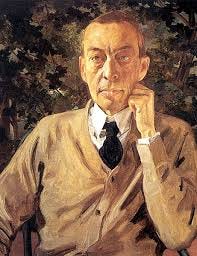
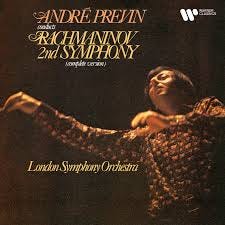
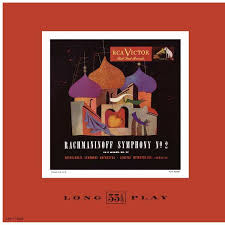
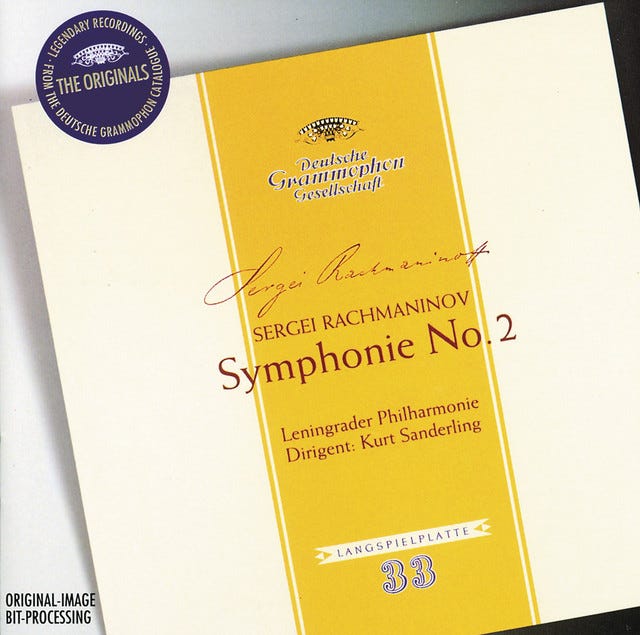
![Rachmaninoff - Eugene Ormandy / The Philadelphia Orchestra – Symphony No. 2 In E Minor, Op. 27 – Vinyl (LP, Album, Stereo), 1960 [r2212988] | Discogs Rachmaninoff - Eugene Ormandy / The Philadelphia Orchestra – Symphony No. 2 In E Minor, Op. 27 – Vinyl (LP, Album, Stereo), 1960 [r2212988] | Discogs](https://substackcdn.com/image/fetch/$s_!EfCF!,w_1456,c_limit,f_auto,q_auto:good,fl_progressive:steep/https%3A%2F%2Fsubstack-post-media.s3.amazonaws.com%2Fpublic%2Fimages%2F2e27882b-6945-4f6e-9c32-b36a9a55137b_300x290.jpeg)
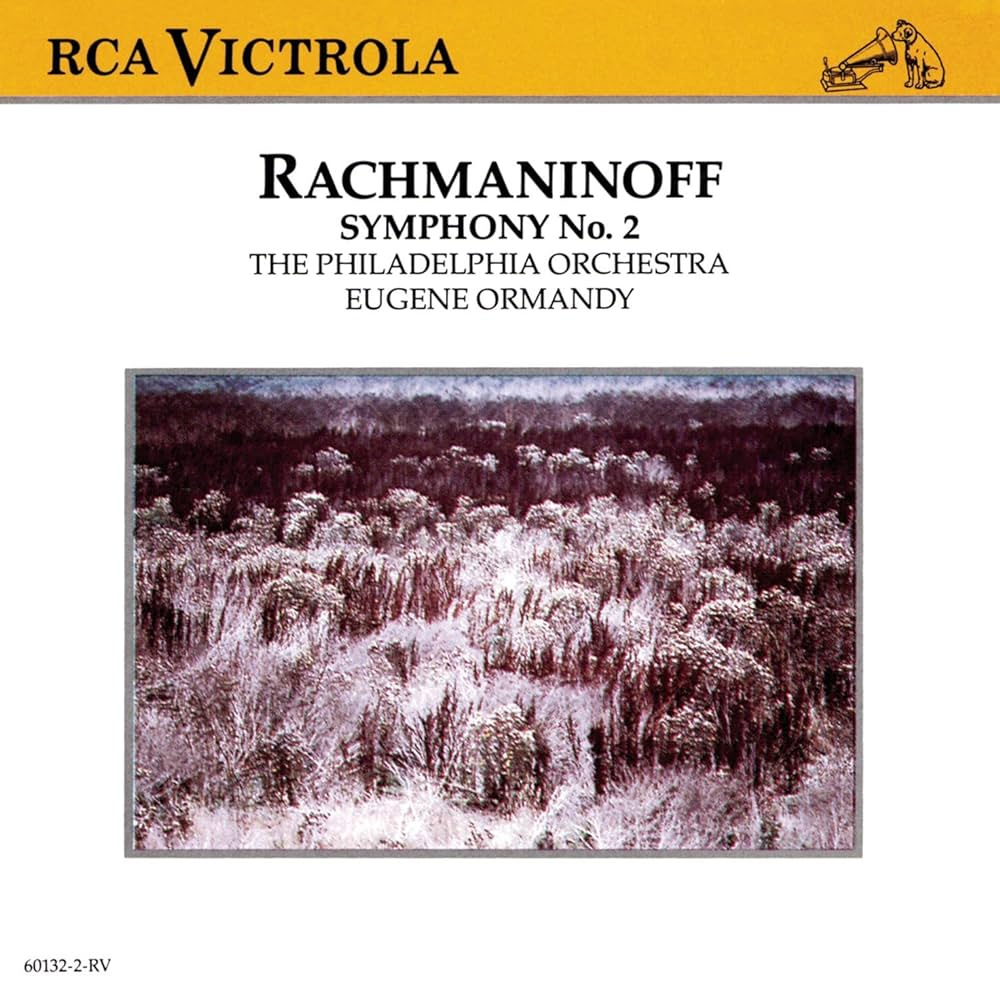
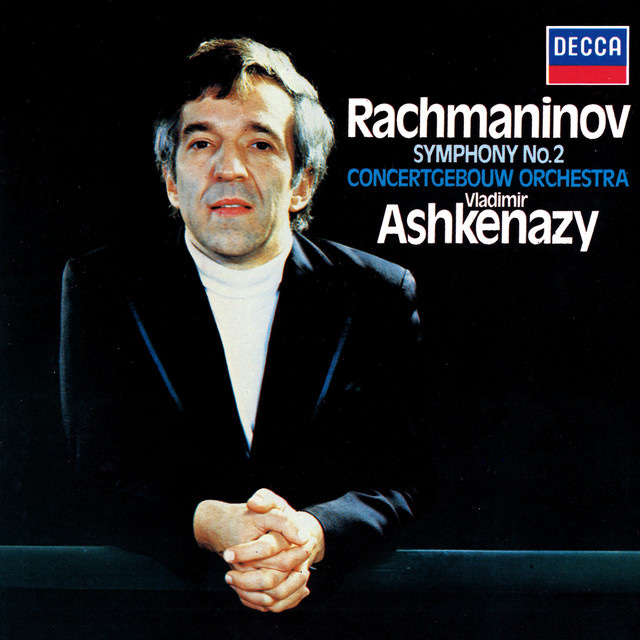
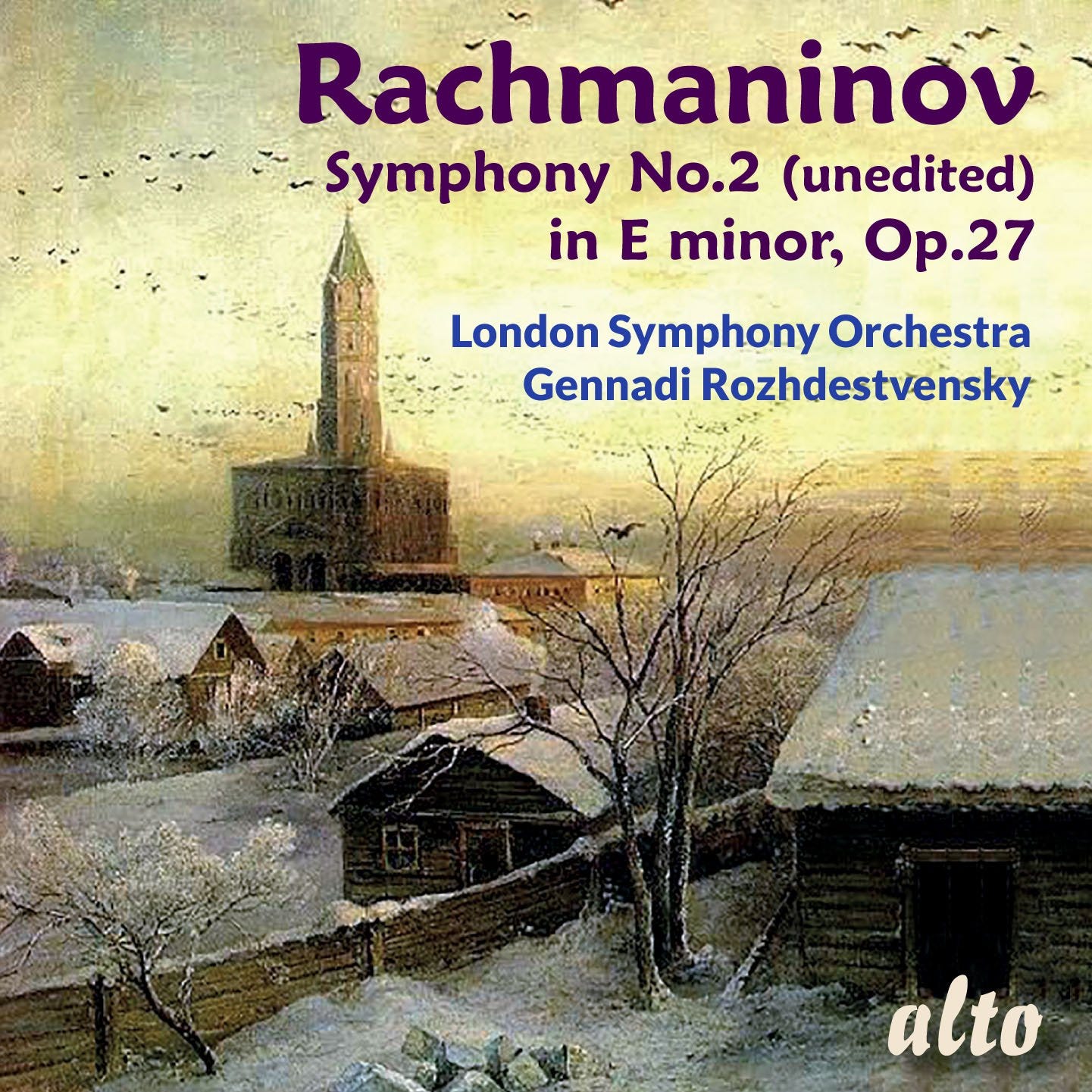
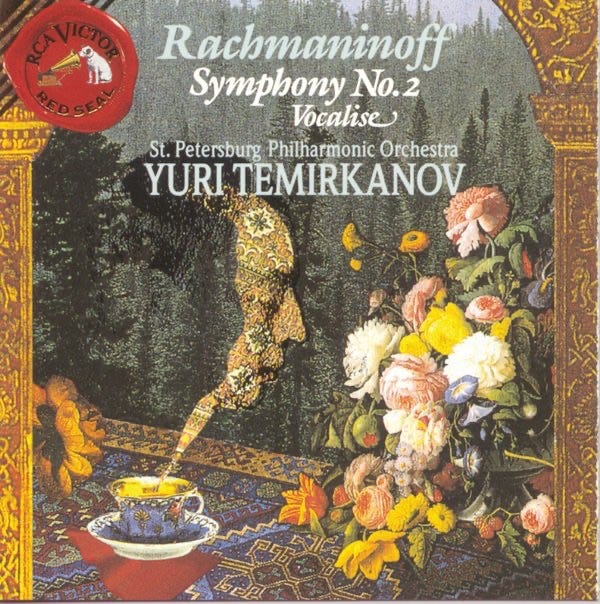
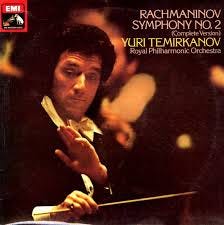
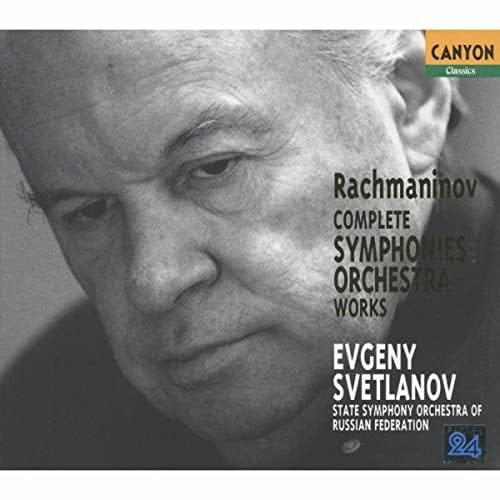
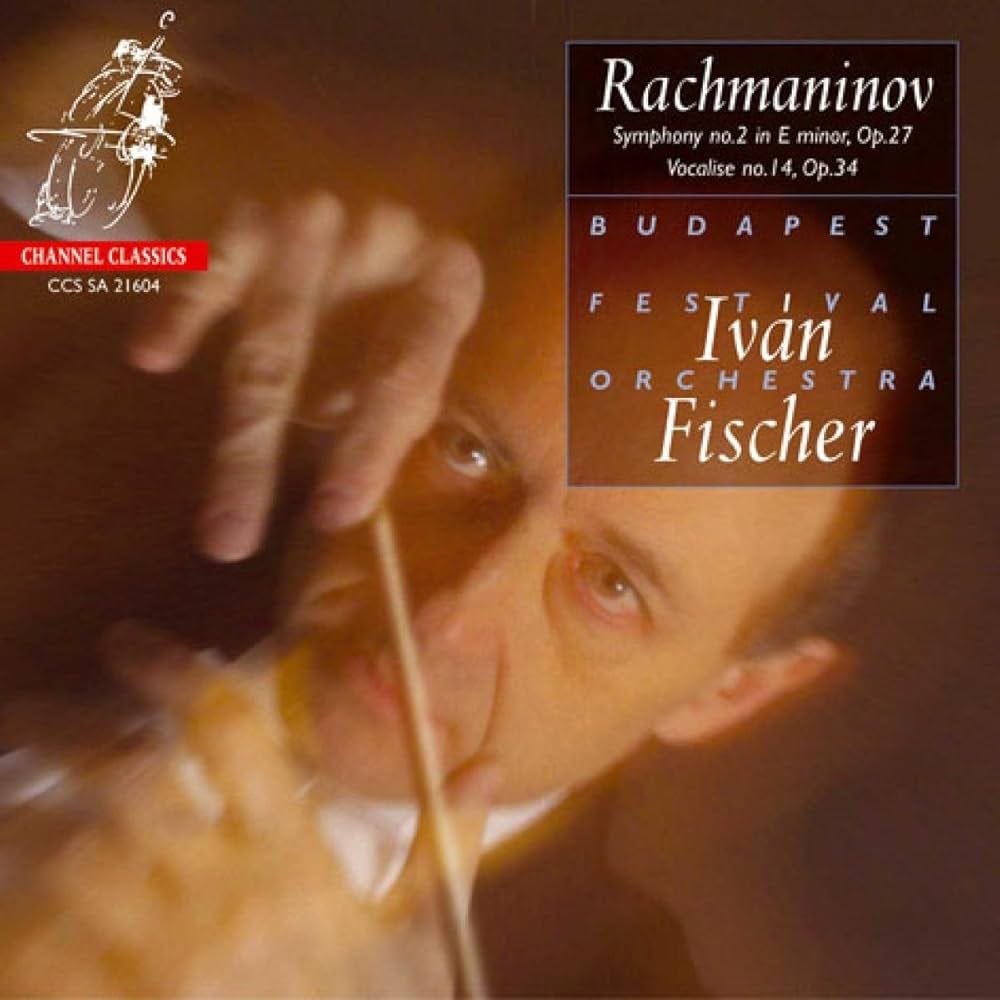
![Rachmaninov: Symphony No. 2 [CD] Rachmaninov: Symphony No. 2 [CD]](https://substackcdn.com/image/fetch/$s_!bA_r!,w_1456,c_limit,f_auto,q_auto:good,fl_progressive:steep/https%3A%2F%2Fsubstack-post-media.s3.amazonaws.com%2Fpublic%2Fimages%2F3469e251-3526-483a-b838-aa6cf96f01d2_1000x891.jpeg)
![Yannick Nezet-Seguin/The Philadelphia Orchestra - Rachmaninoff: Symphonies Nos. 2 & 3; Isle Of The Dead[2 CD] - Amazon.com Music Yannick Nezet-Seguin/The Philadelphia Orchestra - Rachmaninoff: Symphonies Nos. 2 & 3; Isle Of The Dead[2 CD] - Amazon.com Music](https://substackcdn.com/image/fetch/$s_!Hy1s!,w_1456,c_limit,f_auto,q_auto:good,fl_progressive:steep/https%3A%2F%2Fsubstack-post-media.s3.amazonaws.com%2Fpublic%2Fimages%2F797fc9fc-985a-4f7d-95c0-e4de92e63874_1000x1000.jpeg)
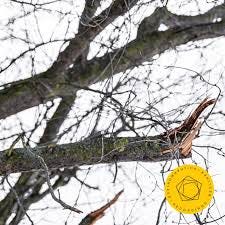
Hi John and thank you for your so valuable work of analysis of each composition. All the best interpretations are here and Previn rightly reigns supreme.
I love the Temirkanov version but I suggest to listen to his first version on EMI with the Royal Philharmonic Orchestra. It's even better and one of the best for me.